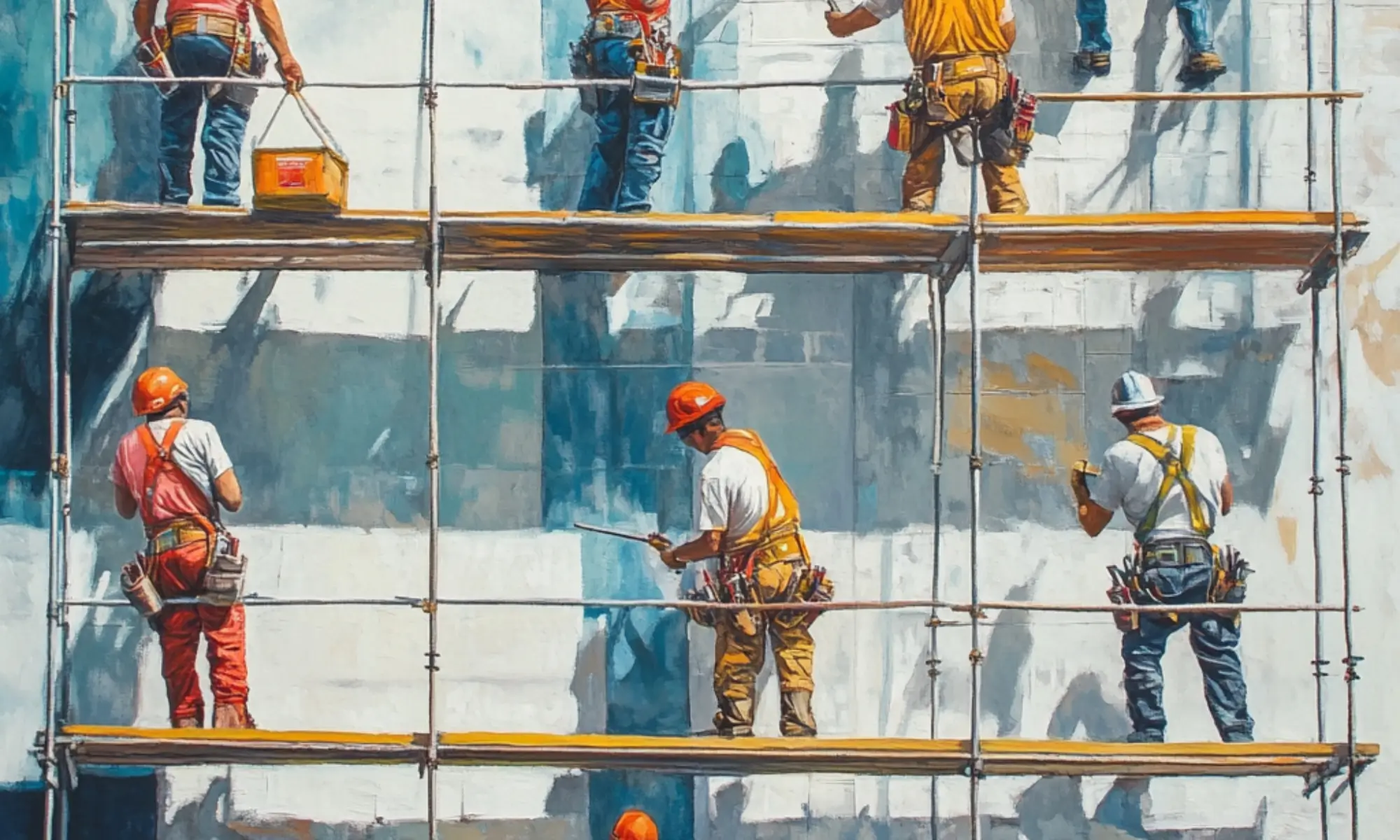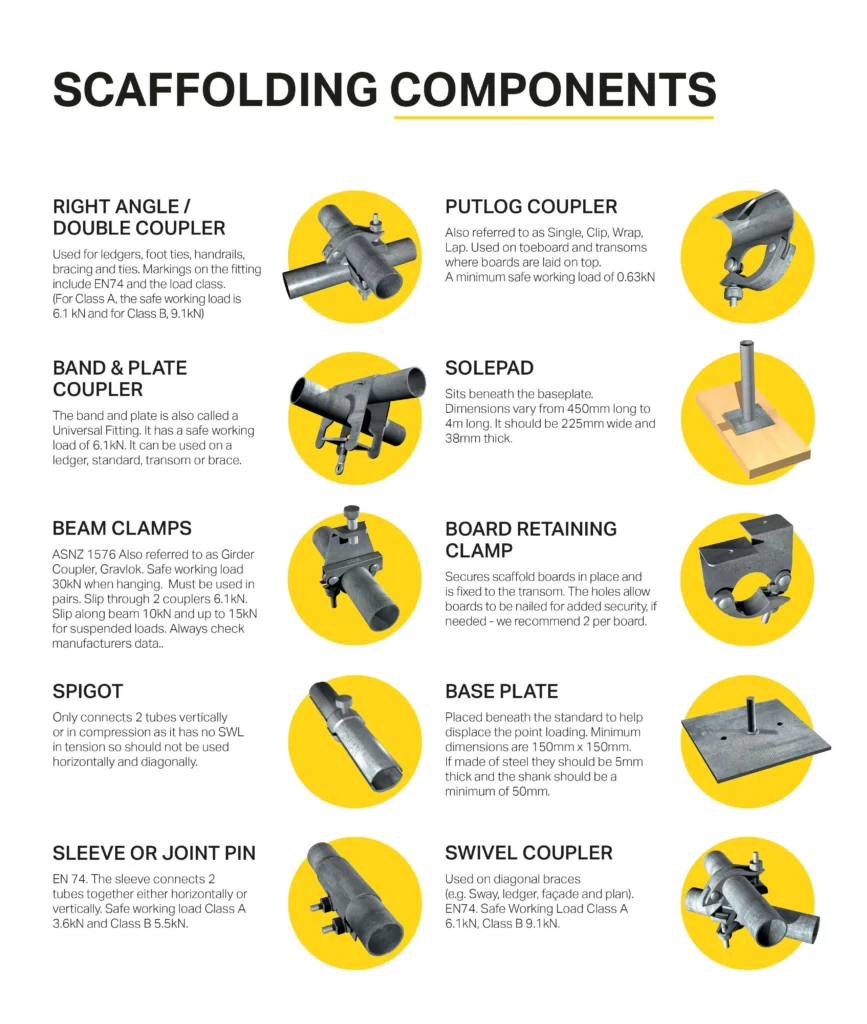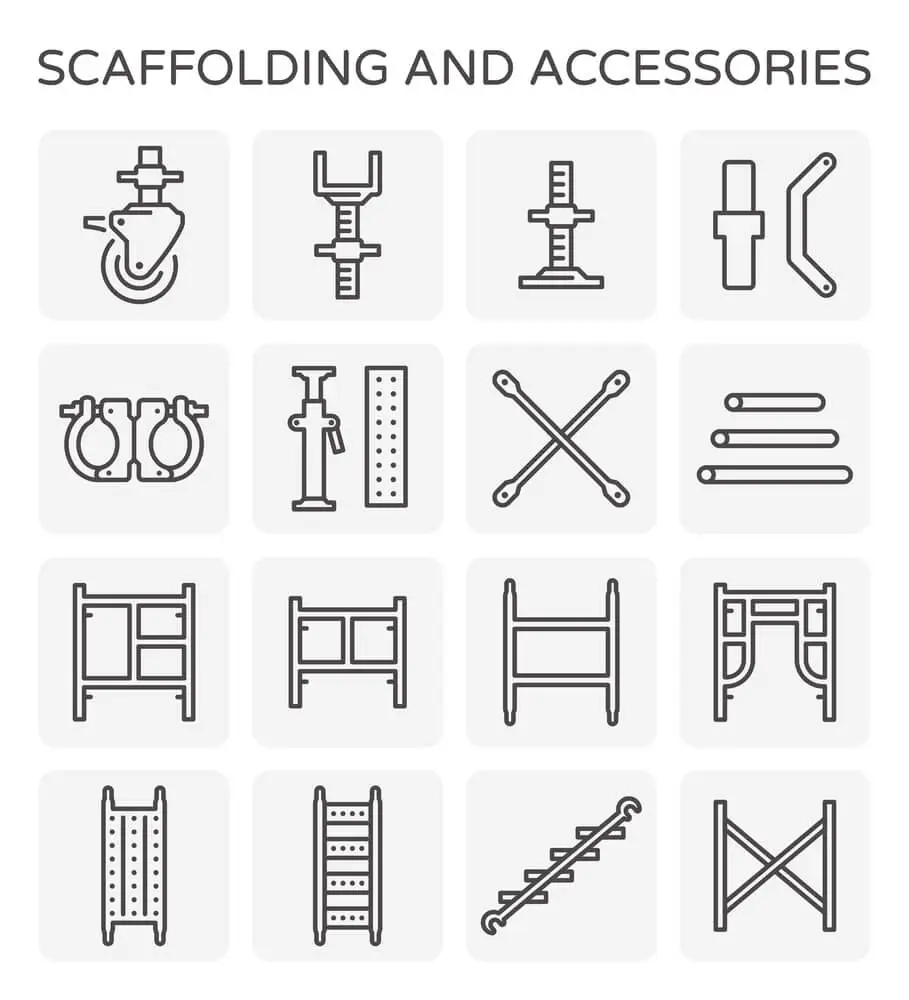Scaffolding is essential to construction and maintenance projects, providing a secure and elevated platform for workers to perform tasks safely and efficiently. Whether it’s erecting a new building, repairing infrastructure, or carrying out maintenance work at height, scaffolding plays a pivotal role in ensuring stability, accessibility, and safety. However, the effectiveness of a scaffolding system lies in its design and the quality of its components.
Understanding the various parts of scaffolding is crucial for proper assembly, usage, and compliance with safety standards. In this blog, we delve into the 11 key components of scaffolding, exploring their functions, importance, and how they come together to create a reliable and safe working structure.

Scaffolding Parts or Components
When it comes to scaffolding parts or components, there are a few key pieces that you need to be aware of. These include ledgers, standards, transoms, braces, and ties. Let’s take a closer look at each one so that you have a better understanding of how they all work together.
1. Standards
Standards are the vertical tubes or poles that form the primary support structure. They transfer the entire weight of the scaffold and its loads directly to the ground or foundation. Standards are connected to horizontal members called ledgers and are typically placed regularly to ensure stability and load distribution. The base of each standard rests on a base plate, which may sit on a sole board to distribute the load over a larger area, especially on softer ground.
Proper installation and alignment of standards are crucial for the scaffold’s overall stability and safety. They must be plumb (vertically straight) and securely connected to other components to prevent any movement or collapse. Regular inspections should be conducted to ensure that standards are free from defects, corrosion, or damage that could compromise the scaffold’s integrity.
2. Ledger
The ledger is a horizontal component crucial in maintaining the structure’s stability and integrity. It runs parallel to the building facade and connects the vertical standards (uprights), providing lateral support and helping to distribute loads evenly across the scaffold.
Key Functions of Ledgers:
- Support for Transoms and Platforms: Ledgers are the foundation for transoms (horizontal cross-members) and the working platforms where workers stand. By supporting these elements, ledgers ensure that the scaffold can bear the necessary loads during construction or maintenance activities.
- Structural Stability: By connecting the standards, ledgers enhance the scaffold’s overall rigidity and prevent lateral movement, contributing to a safe working environment.
3. Transoms
Transoms are horizontal components that are vital to the structure’s stability and functionality. They are placed at right angles to the ledgers (horizontal tubes running parallel to the building) and serve multiple purposes:
- Support for Standards and Platforms: Transoms provide lateral support to the vertical standards (uprights) and offer a base for the working platforms where workers stand.
- Load Distribution: By spanning across ledgers, transoms help distribute the weight of the scaffold and any loads placed upon it, ensuring even load distribution and enhancing structural integrity.
There are two primary types of transoms:
- Main Transoms: Positioned next to the standards, main transoms hold the standards in place and support the boards that form the working platform.
- Intermediate Transoms: Placed between main transoms, these provide additional board support, preventing deflection and ensuring a stable working surface.
Proper installation and spacing of transoms are crucial for the scaffold’s safety and effectiveness. To maintain the scaffold’s structural integrity, they must be securely fixed to the ledgers and standards, typically using right-angle or putlog couplers.
Understanding transoms’ function and correct placement is essential for anyone involved in scaffolding assembly or inspection, as they are integral to the scaffold’s overall stability and safety.

4. Bracing
Bracing refers to the diagonal components that enhance the structure’s stability and rigidity. By preventing lateral movement and swaying, bracing ensures the scaffold remains secure under various loads and environmental conditions.
Types of Bracing:
- Cross Bracing: Consists of two diagonal braces forming an “X” shape between scaffold frames. This configuration provides lateral stability and prevents the scaffold from racking or twisting.
- Diagonal Bracing: Involves single diagonal members connecting different scaffold levels, offering additional support against lateral forces.
- Plan Bracing: Installed horizontally at the base or top of the scaffold, plan bracing helps maintain the scaffold’s shape and prevents deformation.
Importance of Bracing:
- Structural Integrity: Bracing distributes loads evenly across the scaffold, reducing the risk of collapse or failure.
- Safety Compliance: Proper bracing is essential to meeting safety standards and regulations and ensuring a safe working environment for personnel.
- Load Management: Effective bracing allows the scaffold to support dynamic loads, such as wind forces or the movement of workers and materials.
Installation Considerations:
- Correct Placement: Braces should be installed at specified intervals and angles as per design requirements to maximize effectiveness.
- Secure Connections: Use appropriate couplers or clamps to attach braces firmly to standards and ledgers, ensuring they can withstand applied forces.
- Regular Inspections: Conduct routine checks to identify any signs of wear, damage, or loosening in bracing components, addressing issues promptly to maintain scaffold integrity.
Understanding and implementing proper bracing techniques are crucial for the safety and functionality of scaffolding systems. Adhering to best practices and regulatory guidelines helps prevent accidents and structural failures.
5. Base Plates
Base plates are essential components that provide a stable foundation for the entire structure. They are flat, load-bearing plates placed at the bottom of each vertical standard (upright pole) to distribute the scaffold’s weight evenly onto the ground or supporting surface.
Key Functions of Base Plates:
- Load Distribution: Base plates spread the weight of the scaffold and any additional loads, such as workers and materials, over a larger area, reducing the risk of ground subsidence.
- Stability Enhancement: By providing a flat and stable surface, base plates help prevent the scaffold from sinking into soft ground or shifting during use.
- Protection of Standards: They protect the bottom of the vertical standards from direct contact with the ground, which can cause corrosion or damage over time.
Types of Base Plates:
- Fixed Base Plates: Designed for use on flat, level surfaces, these plates provide a stable foundation where ground conditions are consistent.
- Swivel Base Plates: Featuring a pivoting mechanism, swivel base plates are ideal for uneven or sloped surfaces. They allow the scaffold to maintain stability on irregular terrain.
Installation Considerations:
- Surface Assessment: Before installation, evaluate the ground or surface to ensure it can support the scaffold’s load. Additional measures like sole boards (timber boards placed under base plates) may be necessary to distribute weight effectively on soft or uneven ground.
- Secure Placement: Ensure base plates are correctly positioned under each standard and are level to maintain the scaffold’s overall stability.
- Regular Inspections: Conduct routine checks to verify that base plates remain properly seated and are not showing signs of wear or damage.
Using base plates is crucial for the safety and stability of scaffolding structures. Adhering to best practices and manufacturer guidelines ensures a secure working environment for all personnel involved.
6. Sole Boards
Sole boards are essential components that provide a stable foundation for the structure, especially when erected on soft or uneven ground. They are typically made of timber and are placed beneath the base plates of the scaffold’s vertical standards (uprights).
Key Functions of Sole Boards:
- Load Distribution: Sole boards spread the scaffold’s weight and any additional loads over a larger surface area, preventing the base plates from sinking into the ground and ensuring stability.
- Ground Protection: By distributing the load, sole boards protect the underlying surface from damage, which is particularly important when scaffolding is set up on non-structural pavements like block paving, concrete slabs, tarmac, or asphalt.
Specifications:
- Dimensions: A typical sole board measures approximately 225mm in width, 38mm in thickness, and is often around 450mm to 600mm long.
- Material: Sole boards are usually made from strong, durable timber capable of supporting the weight of the scaffolding and any loads that will be placed on it.
Usage Considerations:
- Placement: Each sole board should be positioned under a base plate at the bottom of a standard. The ground beneath must be level and capable of bearing the load.
- Inspection: Regular checks are necessary to ensure that sole boards are in good condition, free from cracks or significant wear, and to maintain scaffold stability.
Proper use of sole boards is crucial for the safety and stability of scaffolding structures. They help prevent accidents by ensuring that the scaffold remains level and secure, even on challenging ground conditions.
7. Working Platform
A working platform in scaffolding refers to the elevated surface where workers perform tasks such as construction, maintenance, or repairs. These platforms are designed to provide a safe and stable area for personnel and their equipment at various heights.
Key Components of a Working Platform:
- Decking/Planks: The horizontal surfaces, typically made of wood, metal, or composite materials, that form the floor of the platform. They must be robust enough to support the intended load.
- Guardrails: Installed along the edges of the platform to prevent falls. Standard configurations include a top rail and a mid-rail.
- Toe Boards are vertical barriers at the platform’s edge that prevent tools or materials from falling off, ensuring safety for workers below.
Safety Considerations:
- Load Capacity: Ensure the platform can support the combined weight of workers, tools, and materials. Overloading can compromise structural integrity.
- Access: Provide safe means of access to the platform, such as ladders or stairways, to prevent accidents during ascent or descent.
- Stability: Regularly inspect the platform for signs of wear, damage, or instability. Proper bracing and secure connections are essential to maintain safety.
Adhering to safety standards and guidelines is crucial when constructing and using working platforms to prevent accidents and ensure a secure working environment.
8. Guardrails
Guardrails are essential safety components that prevent workers from falling off elevated platforms. They form a protective barrier along the open sides and ends of scaffolding platforms, ensuring a secure working environment.
Key Components of Guardrails:
- Top Rail: The uppermost horizontal bar, typically installed at a height between 39 to 45 inches (approximately 1 to 1.15 meters) above the working platform.
- Mid Rail: Positioned midway between the top rail and the platform, the mid rail helps prevent workers from slipping through the space below the top rail.
- Toe Board: A vertical barrier at the platform’s edge, toe boards prevent tools, materials, or debris from falling off the platform, protecting individuals below.
Importance of Guardrails:
- Fall Prevention: Guardrails are a primary means of preventing falls from heights, which are a leading cause of injuries in construction and maintenance work.
- Regulatory Compliance: Many safety regulations mandate using guardrails on scaffolding platforms above certain heights to ensure worker safety.
Installation Considerations:
- Height and Spacing: Ensure that the top rail is installed correctly and that the mid rail is appropriately positioned to provide maximum protection.
- Material and Strength: Guardrails should be constructed from materials capable of withstanding the forces they may encounter, such as steel or aluminium, and should be securely fastened to the scaffold structure.
- Regular Inspections: Conduct routine checks to ensure guardrails are intact, properly installed, and free from damage or corrosion.
By adhering to proper installation and maintenance practices, guardrails significantly enhance the safety of scaffolding operations, protecting workers from potential fall hazards.
9. Toeboards
Toeboards are vertical barriers installed along the edges of platforms to prevent tools, materials, and debris from falling off, thereby protecting workers and pedestrians below. They also serve as a safety measure to prevent workers’ feet from slipping off the platform.
Key Functions of Toeboards:
- Falling Object Prevention: Toeboards act as a barrier to stop objects from accidentally being kicked or knocked off the platform, reducing the risk of injuries to individuals below.
- Foot Protection: They provide a physical edge that helps prevent workers’ feet from slipping off the platform, enhancing overall safety.
Regulatory Requirements:
According to the Occupational Safety and Health Administration (OSHA), toeboards must meet specific criteria:
- Height: Toeboards should be at least 3.5 inches (9 cm) vertically from their top edge to the level of the walking-working surface.
- Clearance: The gap between the bottom of the toeboard and the platform surface should not exceed 0.25 inches (0.6 cm).
- Strength: Toeboards must be capable of withstanding a force of at least 50 pounds (222 N) applied in any downward or outward direction.
Installation Considerations:
- Material: Toeboards can be made from various materials, including wood, metal, or durable plastic, depending on the scaffold’s design and environmental conditions.
- Placement: They should be installed along all open sides and ends of platforms where there is a risk of objects falling.
- Maintenance: Regular inspections are essential to ensure toeboards remain secure and free from damage or excessive wear.
Proper use of toeboards is crucial for maintaining a safe working environment on scaffolding structures. It effectively mitigates hazards associated with falling objects and slips.

10. Couplers
Couplers are essential components used to connect individual tubes, ensuring the structural integrity and stability of the scaffold. They come in various types, each serving a specific purpose in assembling scaffolding systems.
Common Types of Scaffolding Couplers:
- Right-Angle (Double) Couplers join two scaffold tubes at a 90-degree angle, forming a perpendicular connection. They are commonly used in constructing scaffolding frameworks where right angles are required.
- Swivel Couplers: Designed to connect two scaffold tubes at any angle, swivel couplers provide flexibility in creating complex scaffolding configurations, making them ideal for intricate construction projects.
- Sleeve (Joint Pin) Couplers: Used to connect two scaffold tubes end-to-end, sleeve couplers provide a secure and seamless connection, ensuring stability in long spans of scaffolding, particularly useful when extended reach is needed.
- Putlog (Single) Couplers: These couplers secure scaffold tubes to walls or other structures and are commonly used in bricklaying and façade works. They provide a reliable connection between the scaffold and the supporting surface.
- Beam Couplers: Designed to connect scaffold tubes to steel beams or other load-bearing structures, beam couplers provide a reliable connection, allowing scaffolding to be built alongside buildings or in situations where a strong anchor point is required.
Materials and Safety Considerations:
Scaffolding couplers are typically made from durable materials such as steel or aluminum, ensuring strength and longevity in demanding construction environments. Proper selection and use of couplers are crucial for maintaining the safety and stability of scaffolding structures. Regular inspections should be conducted to ensure that couplers are free from defects, corrosion, or damage that could compromise the scaffold’s integrity.
Understanding the various types of scaffolding couplers and their specific applications is essential for constructing safe and efficient scaffolding systems tailored to each project’s unique requirements.
11. Toe boards
Toe boards are vertical barriers installed along the edges of platforms to prevent tools, materials, and debris from falling off, thereby protecting workers and pedestrians below. They also serve as a safety measure to prevent workers’ feet from slipping off the platform.
Key Functions of Toe Boards:
- Falling Object Prevention: Toe boards act as a barrier to stop objects from accidentally being kicked or knocked off the platform, reducing the risk of injuries to individuals below.
- Foot Protection: They provide a physical edge that helps prevent workers’ feet from slipping off the platform, enhancing overall safety.
Regulatory Requirements:
According to the Occupational Safety and Health Administration (OSHA), toe boards must meet specific criteria:
- Height: Toe boards should be at least 3.5 inches (9 cm) vertically from their top edge to the level of the walking-working surface.
- Clearance: The gap between the bottom of the toe board and the platform surface should not exceed 0.25 inches (0.6 cm).
- Strength: Toe boards must be capable of withstanding a force of at least 50 pounds (222 N) applied in any downward or outward direction.
Installation Considerations:
- Material: Depending on the scaffold’s design and environmental conditions, toe boards can be made from various materials, including wood, metal, or durable plastic.
- Placement: They should be installed along all open sides and ends of platforms where there is a risk of objects falling.
- Maintenance: Regular inspections are essential to ensure toe boards remain secure and free from damage or excessive wear.
Proper use of toe boards is crucial for maintaining a safe working environment on scaffolding structures. It effectively mitigates hazards associated with falling objects and slips.
Conclusion
Scaffolding is more than just a temporary structure; it is a vital element in ensuring the safety and efficiency of construction and maintenance projects. Each component, from the sturdy standards to the protective guardrails and toeboards, plays a critical role in creating a stable and secure working environment. Understanding these 11 essential parts of scaffolding helps assemble, maintain, and inspect the system to prevent accidents and ensure compliance with safety standards.
By prioritizing the quality and proper installation of these components, you can enhance worker safety, streamline project execution, and achieve successful outcomes in any project involving working at height. Scaffolding is the backbone of many industries—build it right, and it will support your goals effectively.

